Home made macro filter lens
This topic is locked to prevent further replies.
Aug 15, 2013 22:21:38 #
wingclui44
Loc: CT USA
Trying out my home made macro filter lens, that's a achromatic two element Carl Zeiss 200mm lens, it produced 2x mag. coupling with my Panasonic FZ50 bridge camera setting at max. 425mm on the lens, not bad, I guess!
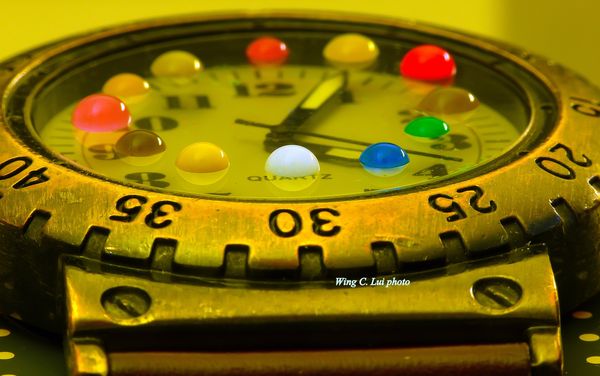
Aug 15, 2013 23:38:35 #
Slick Wing, mind posting a picture of the setup. I'm trying to visualize it but the mental picture escapes me.
Aug 16, 2013 08:51:41 #
wingclui44
Loc: CT USA
A-PeeR wrote:
Slick Wing, mind posting a picture of the setup. I'm trying to visualize it but the mental picture escapes me.
First of all, the lens is one of my collections of optical glass, that I had recovered from the old discarded optical device in the hospital I had worked for 22 years (retired now). It is completely enclosing in a metal house, it is 49mm achromatc doublet. I made it to fit on the front lens of the lumix, which has a 55mm lens threat with a combination of plastic tube and old 55mm uv filter.
It works perfectly when setting the zoom lens on the lumix at 200mm and up.
Here are two pictures to show you the lens and the watch. I used the water paint to make the water drop-lets on the top of the watch which was first treated with Rain-nix (glass treatment, can be obtain at the auto store), it makes the water drop to stay in round shape.
I don't want too strong reflecting light on the water, so I used two flood light pointing to the ceiling and one on the side to get that single reflect light on the water, I didn't use light tent.
W. L.
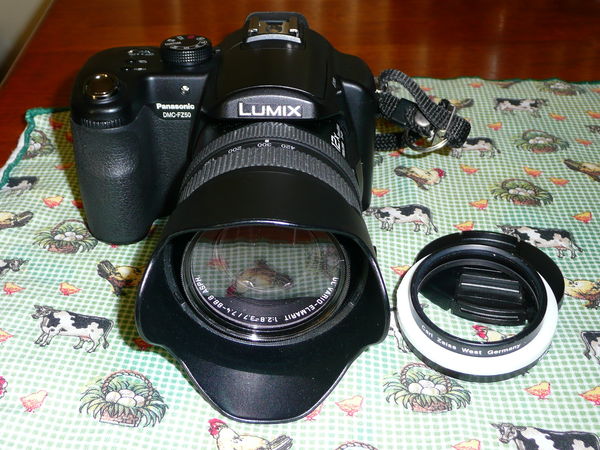
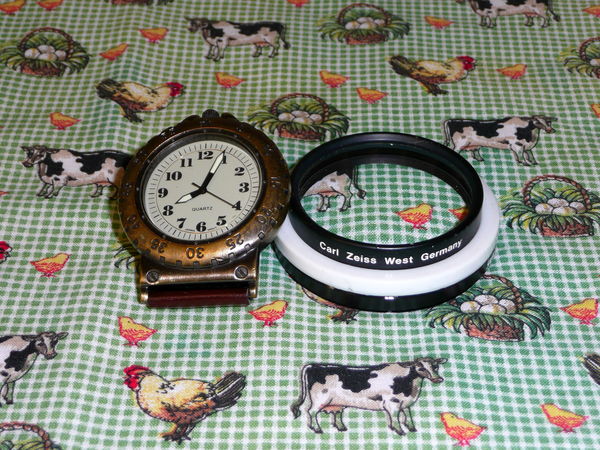
Aug 16, 2013 14:00:44 #
Interesting shots and very nice indeed, however I am not sure how you are computing the magnification, I use reversed lenses and would not be able to fit the face of that watch in a single shot... Did you measure the width of the image against the width of your sensor? When changing setups if I am interested in magnification of the new setup I will shoot a ruler with a mm scale and compare width of the scale captured in the image to the size of my sensor to compute the magnification of that setup.
Aug 16, 2013 14:35:57 #
Panasonic FZ50 bridge camera sensor size = 1/1.8" CCD (7.176-mm × 5.319-mm) per
http://en.wikipedia.org/wiki/Panasonic_Lumix_DMC-FZ50
That means 1:1 magnification (life-size) image captures only 7-mm Field of View (FoV). 2:1 mag (2x life-size) captures a 3.5-mm FoV.
Your image is neither.
http://en.wikipedia.org/wiki/Panasonic_Lumix_DMC-FZ50
That means 1:1 magnification (life-size) image captures only 7-mm Field of View (FoV). 2:1 mag (2x life-size) captures a 3.5-mm FoV.
Your image is neither.
Aug 16, 2013 17:43:58 #
wingclui44
Loc: CT USA
Nikonian72 wrote:
Panasonic FZ50 bridge camera sensor size = 1/1.8" CCD (7.176-mm × 5.319-mm) per
http://en.wikipedia.org/wiki/Panasonic_Lumix_DMC-FZ50
That means 1:1 magnification (life-size) image captures only 7-mm Field of View (FoV). 2:1 mag (2x life-size) captures a 3.5-mm FoV.
Your image is neither.
http://en.wikipedia.org/wiki/Panasonic_Lumix_DMC-FZ50
That means 1:1 magnification (life-size) image captures only 7-mm Field of View (FoV). 2:1 mag (2x life-size) captures a 3.5-mm FoV.
Your image is neither.
I took this image with the zoom lens set at 195mm. so 195/200=0.975. the image is .975/1 life size.
here's a image of a scale taken with full zoom at 425mm.
It covers about 18mm, so the mag. will be 36/18=2(X) full equl. 2/1!
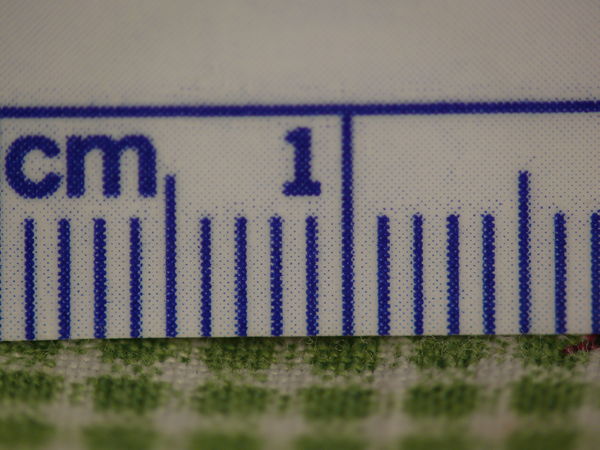
Aug 16, 2013 17:55:10 #
wingclui44 wrote:
I took this image with the zoom lens set at 195mm. so 195/200=0.975. the image is .975/1 life size.
here's a image of a scale taken with full zoom at 425mm.
It covers about 18mm, so the mag. will be 36/18=2(X) full equl. 2/1!
here's a image of a scale taken with full zoom at 425mm.
It covers about 18mm, so the mag. will be 36/18=2(X) full equl. 2/1!
Math is a little backwards, your sensor as Douglass said is 7.176mm wide so you divide 7.176/18mm so you are at something like 1:2.5 without pulling out a calculator... still it is a good pic and a great way to get more out of your camera. The reason that I commented about the magnification is because if I take a pic of a penny at 2:1 magnification I can only get a small portion of the penny in the pic.
Aug 16, 2013 22:29:00 #
wingclui44
Loc: CT USA
Blurryeyed wrote:
Math is a little backwards, your sensor as Douglass said is 7.176mm wide so you divide 7.176/18mm so you are at something like 1:2.5 without pulling out a calculator... still it is a good pic and a great way to get more out of your camera. The reason that I commented about the magnification is because if I take a pic of a penny at 2:1 magnification I can only get a small portion of the penny in the pic.
I took the image of the penny with Vivitar 100mm F2.8 1:1 true macro lens on my D200 DX body (crop factor 1.5) and again another image with my Lumix FZ50 with the 200mm home made filter lens respectively. Please compare them your self. Once again, the mag. power is equal to the focal length of the Primary lens/the focal length of the secondary lens. This applies to extension, tube, bellow and reverse lens stacking also.
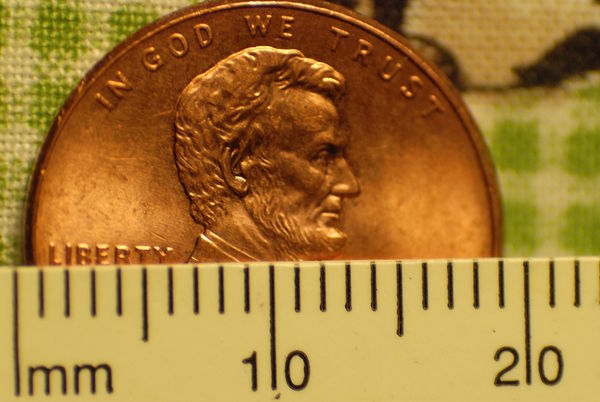
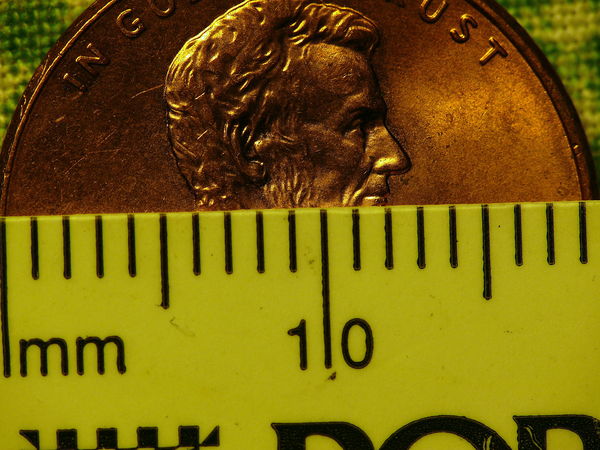
Aug 16, 2013 22:57:38 #
wingclui44 wrote:
I took the image of the penny with Vivitar 100mm F2.8 1:1 true macro lens on my D200 DX body (crop factor 1.5) and again another image with my Lumix FZ50 with the 200mm home made filter lens respectively. Please compare them your self. Once again, the mag. power is equal to the focal length of the Primary lens/the focal length of the secondary lens. This applies to extension, tube, bellow and reverse lens stacking also.
I am not trying to argue with you I am trying to help you understand Macro Math and how it works. When you say that you are shooting at 2X those of us who regularly shoot above 1:1 magnification know if you are properly identifying the magnification of your equipment. The pic that I am posting with this comment I just took so that I could show you what high magnification looks like. We can agree that we are both shooting the same size subject, my image quality may not be so good because I really don't have the light here to focus a reversed lens on tubes. I know because I have measured this setup before that an object just a hair over 7mm will fill my entire frame. Because my sensor on my Canon DSLR is just over 22mm wide, I know that this set up, 22/7.2 is yielding right at 3x mag, 3:1, where your DSLR is filling the frame with about 18mm and your sensor on that Nikon is just over 23mm wide you are shooting at approximately 1.3X mag or 1.3:1
The math that you are quoting only works with reversed stacked lenses, where the secondary lens is mounted backwards to a primary lens, ie a 50mm lens mounted backwards to a 100mm lens. I am not so sure that is what you have done in this example, I can tell you that it is not at 2X. Also there is no math for straight reversed lenses, they have to be measured by taking a picture. as for the stacking math, if you are using a macro lens you can add 1X to the equation, ie my 100mm macro with a 50mm lens reversed mounted to it has a magnification from 2X to 3X depending on how I focus the Macro lens.
Here is a shot of a penny completely uncropped at 3:1
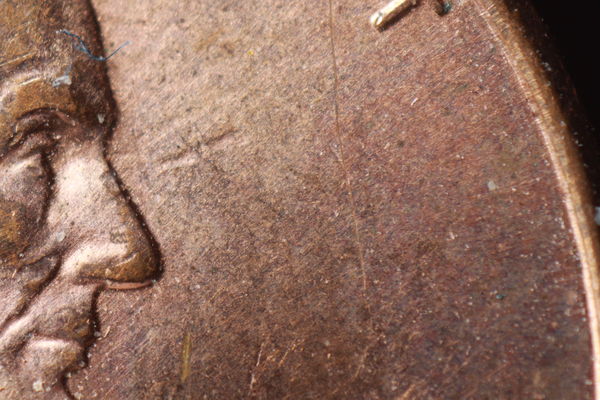
Aug 17, 2013 04:44:21 #
wingclui44 wrote:
Where do you get the '36' number? What does that mean? A 35-mm film camera captures 36-mm wide x 24-mm high, and a Full Frame DSLR is just about the same dimensions. If you captured 18-mm on a Full Frame sensor, you would indeed have 2:1 magnification (2x life-size).here's a image of a scale taken with full zoom at 425mm.
It covers about 18mm, so the mag. will be 36/18=2(X) full equl. 2/1!
It covers about 18mm, so the mag. will be 36/18=2(X) full equl. 2/1!
But YOUR sensor is just 7-mm wide. your magnification is 7:18 = 1:2.58 (1/2.58x life-size) = less than 1/2 life-size.
Aug 17, 2013 08:46:24 #
wingclui44
Loc: CT USA
First, I thank you you both, Blurryeyed and Nikonian72 for your opinion and your valuable knowledge!
I have to clarify that I forgot to mention the photo of the watch I first posted was shoot at about 1:1 ( as I mention on my next post, the zoom at 195mm with the 200mm filter lens on top, 195/200=0.975/1) I only said my set up can make app. 2X life size image if setting the zoom to max. as 420mm.
As Blurryeyed you said you used reverse lens to take the picture of the penny to become 3/1 with you Canon, actually it's 4.8. because you have to consider the crop factor on the Canon, it's 1.6. It's becoming 22/7.2x1.6=4.8!
As I said, the formula as primary focal length over the secondary focal length equals to the magnification of the set up. It works on all but the revers lens.
For your question Nikonian72, The "36" I mentioned was the same as you mention, the length of a full frame film.
My lumix Fz50 has a crop factor of 4.7. As your figure:1/2.58X, so the actual full fame equivalent mag. should be 1/2.58 X 4.7=1.82X.(very close to 2X)
Once again, thank you so much for your respond and I have just learned some thing from you guys, and will continue learning!
I have to clarify that I forgot to mention the photo of the watch I first posted was shoot at about 1:1 ( as I mention on my next post, the zoom at 195mm with the 200mm filter lens on top, 195/200=0.975/1) I only said my set up can make app. 2X life size image if setting the zoom to max. as 420mm.
As Blurryeyed you said you used reverse lens to take the picture of the penny to become 3/1 with you Canon, actually it's 4.8. because you have to consider the crop factor on the Canon, it's 1.6. It's becoming 22/7.2x1.6=4.8!
As I said, the formula as primary focal length over the secondary focal length equals to the magnification of the set up. It works on all but the revers lens.
For your question Nikonian72, The "36" I mentioned was the same as you mention, the length of a full frame film.
My lumix Fz50 has a crop factor of 4.7. As your figure:1/2.58X, so the actual full fame equivalent mag. should be 1/2.58 X 4.7=1.82X.(very close to 2X)
Once again, thank you so much for your respond and I have just learned some thing from you guys, and will continue learning!
Aug 17, 2013 09:56:12 #
If I'm not mistaken it's your sensor size 23mm divided by the 18mm shown on the ruler. Sorry but your math is way off. We are not talking focal length, so you do not multiply by crop factor 1.5.
Aug 17, 2013 11:50:47 #
Well anyway, I think that it is creative how you have used your Rain inx to help form the water drops, and the coloring is neat. I tend to agree with you that with the introduction of all different sized sensor on cameras these days it is hard to determine what is and is not Macro.. a 1:1 shot on my crop camera will look much larger than a 1:1 shot on a full frame sensor. I have seen very experienced macro photographers make the mistake of thinking that full 1:1 shots coming off a full frame camera were not close focused because they were so used to the images of the crop cameras... and your are right, the 1:1 image will display 1.6 times larger from my camera than it would a full frame.
You can even see a slight difference between Canon and Nikon crop cameras...
Hope all this back and forth has not been discouraging regarding this forum.. We tend to be sticklers about some things here but it is also a good place to learn and improve your macro skills.
You can even see a slight difference between Canon and Nikon crop cameras...
Hope all this back and forth has not been discouraging regarding this forum.. We tend to be sticklers about some things here but it is also a good place to learn and improve your macro skills.
Aug 17, 2013 12:14:37 #
wingclui44 wrote:
Blurreyed's calculation is correct. The 22mm factors in the crop factor-- so you would not factor it in again. (22mm x 1.6= 35.2)First, I thank you you both, Blurryeyed and Nikoni... (show quote)
Aug 17, 2013 16:38:06 #
wingclui44 wrote:
My math is fact, not opinion. I am not interested in arguing with you. If you cannot accept the independent calculations of Geff or me, that is your privileged.First, I thank you you both, Blurryeyed and Nikonian72 for your opinion . . .
This is an instructional forum. I will not allow opinion nor mis-information to be presented as fact. Therefore, I am locking this discussion to further posts, as it is too confusing to novice macro-photographers. Your backtracking concerning your use of the number 36 muddies the water, as it has nothing to do with your camera's sensor. Geff and I have independent from one another, presented the factual method of calculating magnification. Nothing else needs to be added to this thread.
If you want to reply, then register here. Registration is free and your account is created instantly, so you can post right away.




